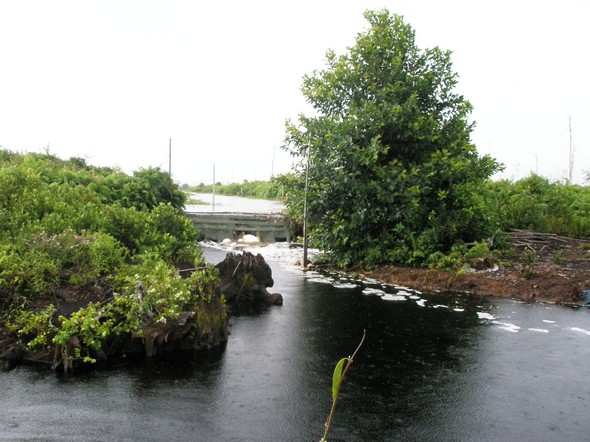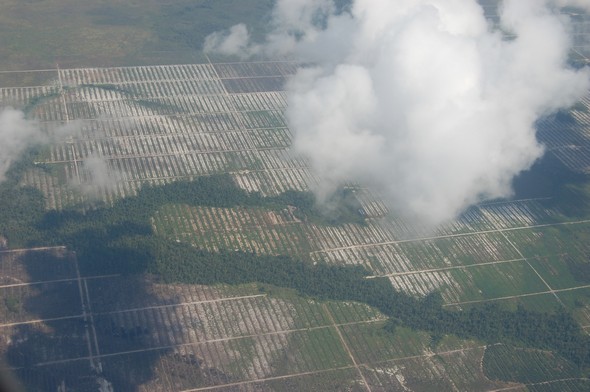Daniel Murdiyarso
Newly planted oil palm plantations in Central KalimantanDaniel Murdiyarso |
The Inter-governmental Panel on Climate Change has reported that land use change, caused mainly by deforestation in developing countries, has contributed up to 17 per cent of the total annual global emission of 26.4 billion tons of CO2 – one of the most important and common greenhouse gases causing global warming and climate change. Regrettably, the United Nations Framework Convention on Climate Change (UNFCCC) Kyoto Protocol did not include avoiding deforestation in its Clean Development Mechanism measures to reduce global greenhouse gas emissions.
Since 2005, when the UNFCCC launched the debate on best approaches to stimulate action to reduce emissions from deforestation in developing countries, forestry emerged as a major focus of the global climate change agenda. Sir Nicholas Stern, the British economist who led the climate change economic analysis known as Stern Review, strongly supported focusing on the forestry sector as a crucial element in reducing the rate of climate change over the next fifty years.
Indonesia is home to vast tropical forests, but with deforestation rates approaching 1.8 per cent annually, it is also among the world’s major emitters of greenhouse gases. Plans to use Indonesian forests to mitigate global climate change present opportunities to explore significant financial benefits to Indonesia, forested regions, and forest communities, while sorting out Indonesian forest governance. Doing so will require Indonesia to prepare itself with changes in forest institutions, regulations and massive public awareness to attract wide participation of the many stakeholders who play a role in Indonesia’s forests.
The Bali Action Plan, adopted at the UN Conference of Parties on climate change in Bali, December 2007 (COP-13), added measures to Reduce Emissions from Deforestation and forest Degradation (REDD). Developing countries could participate on a voluntary basis, and could later replace the Clean Development Mechanism’s limited forestry focus (which expires in December 2012), and which only included afforestation and reforestation, but not conservation of existing forests. The REDD provisions were later changed to ‘REDD+’, which includes benefits for affected forest communities along with mechanisms to conserve existing forests, promote sustainable management of forest, and enhance forest carbon stocks.
A blessing in disguise
Deforestation in Indonesia has many causes, most of them beyond the forestry sector. These extra-sectoral drivers include plans to convert forest to other land uses, especially agriculture, infrastructure, and human settlement. While recent deforestation rates have fluctuated, between 1990 and 2005 estimates indicate that deforestation in Indonesia has released between 2.4 and 10.3 billion tons of CO2, or on average about 700 million tons of CO2 per year.
These figures represent removal of biomass stored above ground – trees and other vegetation. Since Indonesia also has some 21 million hectares of peat swamp forests, emissions from draining and burning peatlands following the oxidation of organic materials above ground and in peat soils add even more greenhouse gas emissions. From 2000 to 2005 (the last year for which reliable figures are available), Indonesian peat swamps were deforested at a rate of around 100,000 hectares per year. Emissions due to peatland drainage were estimated around 1,200 million tons of CO2 per year and fire emissions during the same period amounted to some 800,000 tons of CO2 per year.
Altogether, land based emissions from Indonesian deforestation are well above 2.7 billion tons of CO2 per year. This is a huge amount from a single country, surpassing several developed countries’ emissions. Overall, Indonesia’s forests have recently emitted more CO2 to the atmosphere than they have absorbed.
Overall, Indonesia’s forests have recently emitted more CO2 to the atmosphere than they have absorbed
Such high rates of land based emissions have made Indonesia infamous. However, they may present an opportunity, a ‘blessing in disguise’. Indonesian authorities are now recognising their country’s high emission rate, and scientists are working to establish a credible baseline to which controlled emissions can be compared. This could make a huge difference to land use policies, by prioritising policies that limit conversion of peat swamp forests, peatland drainage, and burning.
Wise use of peatlands to mitigate climate change through sustainable forest management would give Indonesia a huge opportunity to improve forest governance. This should be seen as a long term strategic goal. The fact that the REDD+ global mechanism would provide compensation or payment for reducing emissions should be considered a bonus added to the collateral benefits emerging from the conservation of biodiversity, water regimes and other environmental services. Giving up the opportunity to use Indonesia’s peat swamp forests as part of the global effort to mitigate climate change is like letting ‘low-hanging fruits’ just drop and rot.
However, the challenges involved in governing the peatlands is huge. Unless a planned REDD+ Agency is given a strong mandate, there is no single authority that has the authority to provide clear direction as far as climate mitigation and sustainable livelihoods are concerned. Yet inclusion of peatlands and wetlands in general (including mangrove and coastal wetlands) into Indonesia’s climate change mitigation effort is appropriate and timely as the Inter-governmental Panel on Climate Change is preparing new methodologies for these ecosystems and expected to be completed in 2013.
Logging moratorium
On May 20, 2011, Indonesia’s President ordered a moratorium on new logging permits. The moratorium, embodied in Presidential Instruction (Inpres) Number 11 of 2011 will suspend issuance of new permits to convert primary forest and peatlands to other uses. This two-year suspension might provide some breathing space to rearrange forest governance. It is not clear, however, how much forest land will actually be protected under the moratorium.
 |
Blocking a canal to alleviate peatland draining and avoid oxidation, Central KalimantanDaniel Murdiyarso |
The nature of a Presidential Instruction in the Indonesian system is basically a set of instructions to the concerned ministries and other government agencies to implement the policies stipulated in the order, but with no sanctions or consequences if the instructions are not implemented. The effectiveness of the policy is currently attracting much public scrutiny, as there are a number of exceptions which could potentially undermine the president’s own commitment to reduce emissions from 26 per cent to 40 per cent by 2020.
Since the policy explicitly concerns primary forests and peatlands, varied interpretations among stakeholders remain a challenge. For example, the instruction does not specify how existing logging and land conversion permits should be evaluated, and possibly revoked, if they do not meet criteria related to the effort to reduce emissions from deforestation. Does specifying peatlands explicitly include protection for all types and depths of peat soils, regardless of their location or jurisdiction? (Until now, peat soils less than three meters deep have been considered exempt from peatland protection policies when it comes to issuing permits for agricultural conversion of peatlands). Such issues should be quickly resolved. Prioritising peatlands will provide a golden opportunity to mitigate climate change and to some extent gain financial rewards.
In a nut shell, Indonesian forests and peatlands offer challenging opportunities to mitigate climate change when managed properly. But that is a major challenge. Redesigning forest governance is vital and engaging wide public participation is necessary for Indonesia to ensure effective greenhouse gas emission reduction.
Daniel Murdiyarso (d.murdiyarso@cgiar.org) is Professor of Atmospheric Sciences, Bogor Agricultural University (IPB) and Senior Scientist at the Center for International Forestry Research (CIFOR) in Bogor.
